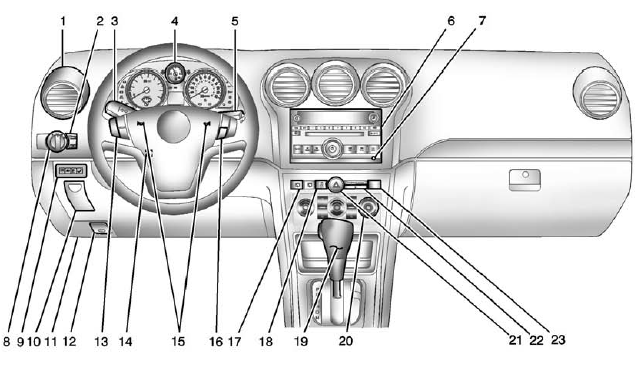Chevrolet Captiva Owners Manual: Instrument Panel
Instrument Panel Overview

- Air Vents on page 8-9.
- Instrument Panel Illumination Control on page 6-4.
- Turn Signal Lever. See Turn and Lane-Change Signals on page 6-3.
- Instrument Cluster on page 5-9.
- Windshield Wiper/Washer on page 5-3.
- AM-FM Radio on page 7-5.
- Auxiliary Input Jack (If Equipped). See Auxiliary Devices on page 7-20.
- Fog Lamps on page 6-4.
Exterior Lamp Controls on page 6-1.
- Driver Information Center (DIC) Buttons. See Driver Information Center (DIC) on page 5-24.
- Instrument Panel Storage on page 4-1.
- Data Link Connector (DLC) (Out of View). See Malfunction Indicator Lamp on page 5-14.
- Hood Release. See Hood on page 10-3.
- Cruise Control on page 9-30.
- Steering Wheel Adjustment on page 5-2.
- Horn on page 5-3.
- Steering Wheel Controls on page 5-2 (If Equipped).
- Rear Window Wiper/Washer on page 5-4.
- Traction Control/Electronic Stability Control on page 9-28.
- Shift Lever. See Automatic Transmission on page 9-21.
- Climate Control Systems on
page 8-1 (If Equipped).
Automatic Climate Control System on
- Hazard Warning Flashers on page 6-3.
- Passenger Airbag Status Indicator. See Passenger Sensing System (United States) on page 3-24.
- Passenger Safety Belt Reminder. See Safety Belt Reminders on page 5-11.
Instrument panel in the Chevrolet Captiva (2006-2018) provides essential information about the vehicle's status and performance. It typically includes a combination of gauges, warning lights, and digital displays to keep the driver informed while on the road. Understanding the layout and functions of the instrument panel is crucial for safe and efficient driving.
At the center of the instrument panel, you'll find the speedometer, which displays the vehicle's current speed in miles per hour (mph) or kilometers per hour (km/h), depending on the region. Next to the speedometer, there's often a tachometer that indicates the engine's revolutions per minute (RPM), providing valuable information about engine speed.
Other common features on the instrument panel include a fuel gauge, which shows the fuel level in the tank, and a temperature gauge that monitors the engine coolant temperature. Additionally, modern vehicles may have digital displays for odometer readings, trip information, tire pressure monitoring, and more.
Warning lights are also an integral part of the instrument panel, alerting the driver to potential issues such as low fuel, engine overheating, battery problems, or malfunctions in the vehicle's systems. Familiarizing yourself with the meanings of these warning lights and their corresponding actions can help you respond appropriately to any issues that may arise while driving.
 In Brief
In Brief
...
 Initial Drive Information
Initial Drive Information
This section provides a brief
overview about some of the
important features that may or may
not be on your specific vehicle.
For more detailed information, refer
to each of the features which c ...
More about:
Chevrolet Captiva Owners Manual > Initial Drive Information: Transmission
Electronic Range Select (ERS) Mode
ERS mode allows you to choose the
top-gear limit of the transmission
and the vehicle's speed while
driving downhill or towing a trailer.
To use this feature:
Move the shift lever to
M(Manual).
Press the plus/minus button
located on the shif ...
Chevrolet Captiva Owners Manual
- Introduction
- In Brief
- Keys, Doors, and Windows
- Seats and Restraints
- Storage
- Instruments and Controls
- Lighting
- Infotainment System
- Climate Controls
- Driving and Operating
- Vehicle Care
- Service and Maintenance
- Technical Data
- OnStar
